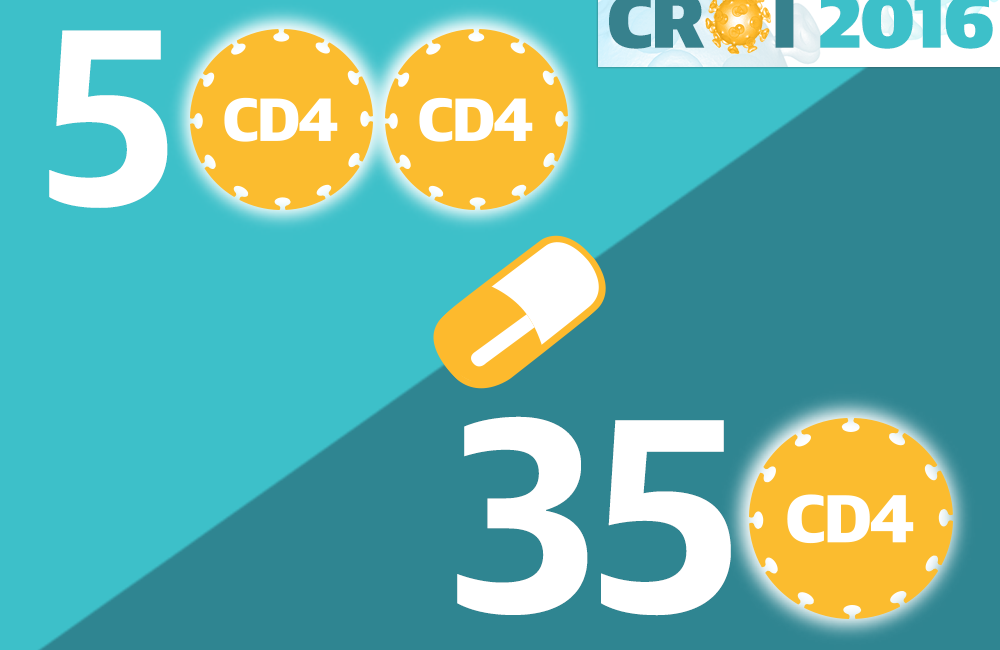
People who started antiretroviral therapy at a CD4 cell count above 500 had a significantly lower risk of developing a cancer with an infectious cause when compared to people who started treatment at a CD4 count of 350 or below, an analysis of the START study presented at the Conference on Retroviruses and Opportunistic Infections (CROI 2016) in Boston has shown.
The primary analysis of the START study showed that early treatment reduced the risk of cancer by 64% but did not differentiate between cancers of infectious and non-infectious causes. The analysis presented today showed that early treatment reduced the risk of infection-related cancer by approximately 75% and halved the risk of non-infection-related cancers.
Cancers of infectious causes include those related to human papillomavirus (HPV, associated with cervical cancer, anal cancer and cancers of the head and throat), Kaposi’s sarcoma (HHV-8), Hodgkin lymphoma and non-Hodgkin lymphoma (Epstein-Barr virus). The viruses that contribute to the development of these cancers are more prevalent in many populations of people living with HIV and so the prevention of these cancers is a particular priority in people living with HIV.
The START study randomised people with HIV with CD4 cell counts above 500 cells/mm3 to start treatment immediately or defer treatment until their CD4 cell counts fell to 350 cells/mm3 or below. The study found that early treatment reduced the risk of serious AIDS-related events, serious non-AIDS events and death by 57%, and the risk of developing any cancer by 64%. When the findings were presented in 2015 investigators said that they found no difference in the impact of early treatment on cancers of infectious or non-infectious cause, but the analysis presented today has revisited the question in more detail.
Fourteen people in the immediate-treatment arm developed cancer (six infection-related and eight infection-unrelated) compared to 39 people in the deferred-treatment arm, a reduction in risk of 74% (Hazard Ratios [HR]: 0.26; 95% confidence interval 0.11-0.64, p = 0.003) for infection-related cancers and 51% for non-infection related cancers (HR 0.49; 95% CI 0.21-1.15).
Twenty-nine cancers with an infectious cause occurred (six in the immediate arm and 23 in the deferred arm). These were predominantly Kaposi’s sarcoma (eleven in the deferred arm and one in the immediate arm) and non-Hodgkin lymphoma (nine in the deferred arm and one in the immediate arm). There was one case of Hodgkin lymphoma in each study arm, one case of anal cancer and one case of cervical cancer in the immediate arm and two cases of anal cancer in the deferred arm.
Twenty-four cancers with a non-infectious cause occurred (eight in the immediate arm and 16 in the deferred arm). Prostate and lung cancer occurred more frequently, and a wider range of cancers occurred in the deferred arm, but there was no substantial difference in the incidence of any particular cancer between the two arms.
Whereas the annual cancer rate remained stable in people in the immediate group, the annual incidence of both infectious and non-infectious cancers increased over time in the deferred group.
Independent predictors of infection-related cancer were older age (1.42; 0.99-2.02 per 10y), higher BMI (1.08; 1.01-1.16 per kg/m2), low income region (0.32, 0.14-0.74 for high vs low income) and HIV RNA (2.32; 1.35-3.98 per 1log higher). Older age was the only independent predictor of infection-unrelated cancer (2.58; 1.75-3.81 per 10y).
Borges AH et al. Immediate ART initiation reduces risk of infection-related cancer in HIV infection. Conference on Retroviruses and Opportunistic Infections, Boston, abstract 160, 2016.
